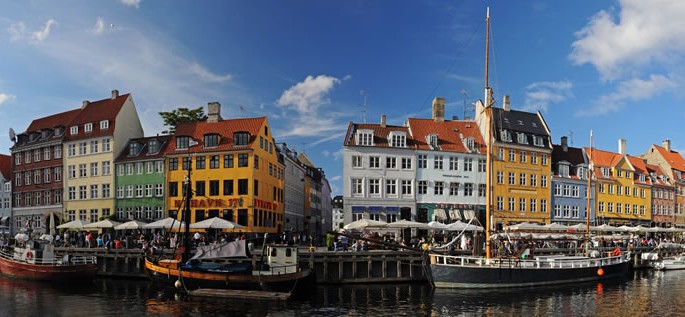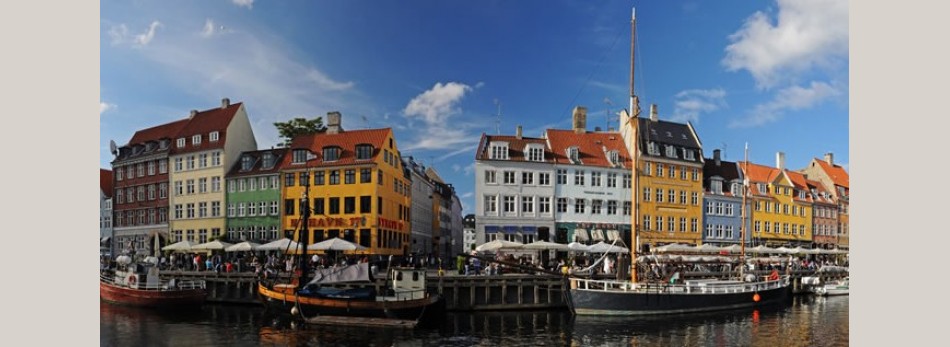Danish

Danish (Dansk) belongs to the East Scandinavian group of the Germanic branch of the Indo-European language family. It is spoken by 5.4 million people in Denmark. It is also spoken in Canada, Germany, Greenland, Iceland, Norway, Sweden, United Arab Emirates, USA. The total number of speakers of Danish worldwide is estimated at around 5.6 million (Ethnologue).
Danish is closely related to Norwegian and Swedish. The three languages developed from Old Norse which was spoken in the areas of Scandinavia that are now Norway, Denmark and Sweden. To this day, Danes, Norwegians, and Swedes can talk to each other without an interpreter. Despite the high degree of mutual intelligibility it would not be correct to call the three languages dialects, because Danes, Norwegians, and Swedes see these languages as standardized official languages of their respective countries with separate norms for speaking and writing.
Danish and Swedish became unitary standardized languages earlier than Norwegian. They developed an independent status from the time of the Reformation when the Bible was translated into each of them.
-
Danish
Denmark’s got its own Lutheran Church and its own Bible. It developed a written language based on the language spoken in and around Copenhagen. It imposed this language on Norway as well. -
Swedish
After Sweden gained its independence from Danish rule in 1526, it developed a written language based on the language spoken in and around Stockholm. When the Swedish military power took over Danish and Norwegian provinces, they also adopted Swedish writing. -
Norwegian
Norwegians learned to write Danish during the 4 centuries of domination by Denmark (c. 1380-1814). However, the spoken language developed along different lines. After the Norwegians won their independence from Denmark, they were left with a standardized spoken language which, although written like Danish, differed from it in its sound system and vocabulary. This language is known today as bokmål. Thus, bokmål is a descendant of Old Norwegian in its spoken form, and Old Danish in its written form.
Danish is the de facto national language of Denmark (Ethnologue). It is the national language of Greenland along Greenlandic Inuktitut, and a compulsory subject in primary schools on Faroe Islands. In addition, Danish is used by the Danish minority in Southern Schleswig, an area of Germany bordering Denmark, where it has the status of a protected minority language.
Dialects
Danish is usually divided into two major dialect groups (Ethnologue).
- Bornholmsk (Eastern Danish)
- Sønderjysk (Southern Jutlandic)
Standard Danish is based on Eastern Danish spoken in and around the capital of Copenhagen. It is spoken in the big cities, taught in schools, and used in the media. Since Denmark’s territory consists of many islands and peninsulas, there are many other regional dialects, not all of them mutually intelligible.
Structure
There are differences in pronunciation among the various dialects of Danish. The description below is based primarily on Standard Danish.
Vowels
Danish has a very large inventory of vowels, most of which can be either long or short, rounded or unrounded. Vowel length makes a difference in word meaning. It is indicated by a colon after the vowel in the table below. Rounded vowels are produced with rounded protruding lips.
| Front | Central | Back | |||
| Unrounded | Rounded | Unrounded | Rounded | ||
| Close | i, i: | y, y: | u, u: | ||
| Mid | e, e: | ø, ø: | ə | o, o: | |
| Open-mid | ɛ: | ɐ | ʌ | ɔ, ɔ: | |
| Open | a | ɑ, ɑ: | ɑ, ɑ: | ||
- /y/ is similar to the second vowel in statue
- /ø/ has no equivalent in English
- /ə/ = a in about
- /ɛ/ = e in bed
-
/ɔ/ = vowel in ought
Consonants
Danish has 17-18 consonants, depending on the analysis.
|
Bilabial
|
Labio-
dental |
Alveolar
|
Alveo-
palatal
|
Velar
|
Uvular
|
Glottal
|
||
|---|---|---|---|---|---|---|---|---|
| Stops |
aspirated
|
pʰ
|
tʰ
|
kʰ
|
||||
|
plain
|
p
|
t
|
k
|
|||||
| Fricatives |
voiceless
|
f
|
s
|
ʃ |
h
|
|||
|
voiced
|
v
|
|||||||
| Nasals |
m
|
n
|
ŋ
|
|||||
| Laterals |
l
|
|||||||
| Semivowels |
ʋ
|
ð
|
j
|
ʁ
|
- /pʰ, tʰ, kʰ/ are aspirated, i.e., pronounced with a burst of air that accompanies their release.
- /ʃ/ = sh in shop
- /ð , ʋ, ʁ/ have no equivalents in English
Stress
Stress in native Danish words normally falls on the first syllable. Loanwords may have other stress patterns.
Pitch accent (Stød)
Danish has a pitch accent, known as stød. It is is realized as a glottal catch, or creaky voice which is sometimes called laryngealization, because the tight compression of the vocal cords causes them to vibrate at frequencies below the frequency of a normal voice. In most dialects of Danish, stød can occur only in syllables that are stressed and end in a voiced consonant.
Danish grammar is similar to the grammar of other Germanic languages, including English.
Nouns, adjectives, pronouns
Gender and number are conflated into one ending.
- Nouns have two grammatical genders: common and neuter. Inanimate objects are usually neuter. For the most part, gender is not predictable. It is marked by accompanying modifiers and referential pronouns, and by the forms of the plural.
- There are two numbers: singular and plural.
- The definite and indefinite articles agree with the noun in gender and number in the singular, e.g., en dag ‘a day, dagen ‘the day’, dagene ‘the days’.
- There are no case markings, except for the possessive –s, e.g., dags ‘day’s’.
- Adjectives have no case endings but are marked for definiteness, gender, and number.
- The pronominal system is very much like that of English. However, there is a distinction between the informal 2nd person singular du, and the formal De.
Verbs
- Verbs are not marked for person or number.
- Verbs can be weak or strong. Weak verbs add endings to the root of the verb to form the preterit. Strong verbs undergo a vowel change in the root, often with no ending added. There are 7 classes of strong verbs.
- The perfect and pluperfect tense is formed with the auxiliary har ‘have’, e.g.,har set ‘have seen’, havde set ‘had seen’.
- There are three moods: indicative, imperative, and subjunctive.
- There are three voices: active, middle, and passive.
Word order
The normal word order in declarative sentences is Subject-Verb-Object. In questions, the order is Verb-Subject-Object.
Most Danish words are derived from Old Norse and Middle Low German. Later borrowings came from standard German, French and English. New words are formed by compounding, e.g., datamaskine ‘computer’ from data + maskine ‘machine,’ lufthavn ‘airport’ from luft ‘air’ + havn ‘port,’ fjernsyn ‘television’ from fjern ‘distant’ + syn ‘vision.’ A good example of compounding is found in Verdebserklaeringen ‘universal declaration’ and Menneskrrettighederne‘human rights.’
Below are a few common phrases and words in Danish.
| Hello. | Hej. |
| Good bye | Farvel. |
| Please. | Vær så venlig at. |
| Thank you. | Tak. |
| I am sorry | Undskyld. |
| Yes | Ja |
| No | Nej |
| Man | Mand. |
| Woman | Kvinde. |
Below are the Danish numerals 1-10.
|
1
|
2
|
3
|
4
|
5
|
6
|
7
|
8
|
9
|
10
|
|
en
|
to
|
tre
|
fire
|
fem
|
seks
|
syv
|
otte
|
ni
|
ti
|
Danish uses a vigesimal counting system, i.e., one that counts in 20s, for numerals from 50 to 90. For example, sixty is tres, an abbreviated form of tre-s(inds-tyve) ‘3 x 20’.
Writing
Danish uses the standard 26 letters of the Latin alphabet, plus three additional vowels æ, ø, å which are traditionally listed at the end of the alphabet. The same alphabet is used for writing Norwegian. There are 9 vowel and 20 consonant symbols.
|
A a
|
B b
|
C c
|
D d
|
E e
|
F f
|
G g
|
H h
|
I i
|
J j
|
K k
|
L l
|
M m
|
N n
|
O o
|
|
P p
|
Q q
|
R r
|
S s
|
T t
|
U u
|
V v
|
W w
|
X x
|
Y y
|
Z z
|
Æ æ
|
Ø ø
|
Å å
|
- The letters q, w, x, z are used almost exclusively in loanwords and foreign names.
Take a look at Article 1 of the Universal Declaration of Human Rights in Danish.
|
Verdebserklaeringen om Menneskrrettighederne Artikel 1.Alle mennesker er født frie og lige i værdighed og rettigheder. De er udstyrede med fornuft og samvittighed, og de bør handle mod hverandre i en broderskabens ånd. |
|
Universal Declaration of Human Rights Article 1 All human beings are born free and equal in dignity and rights. They are endowed with reason and conscience and should act towards one another in a spirit of brotherhood. |
Did You Know?
English has borrowed a few words from Danish (Norwegian). Here are some of them.
| English word | from Danish (Norwegian) |
| drip | drippe ‘drip’ |
| fog | fog ‘spray, shower, snowdrift’ |
| rift | rift ‘cleft’ |
| skulk | skulke ‘to shirk, malinger’In the phonology section I’ve found two errors: |








/ç/ is pronounced as the digaph “ch” in German “ich” (1st person pronoun, nominative). This consonant phoneme does not appear in native Danish words.
/ð/ has an English equivalent: the digraph “th” in “that”, but not as “th” in “thunder”. This phoneme is known as the ‘voiceless dental fricative’.
The Danish stress typically falls on the penultimate syllable, rather than the first.
A Danish syllable is not necessarily long, if the “stød” occurs in it.
The 1st universal declaration of human rights is incorrect. This should be corrected to.
“Alle mennesker er [f]ødt frie og lige i værd[i]ghed og rettigheder. De er udstyre[de] me[d] [f]ornuft og sam[vi]ttighed, og de bør handle mod hverandre i en broderskabe[n]s (the expression is grammatically incorrect. The noun (broderskab) is definite, even though it is preceded by an indefinite article (en). The noun (broderskab) is neuter in its grammatical gender, but not is not treated as so in the expression) ånd.”
http://frontype.com/keyboard/Danish-keyboard-layout.html